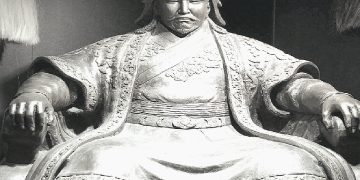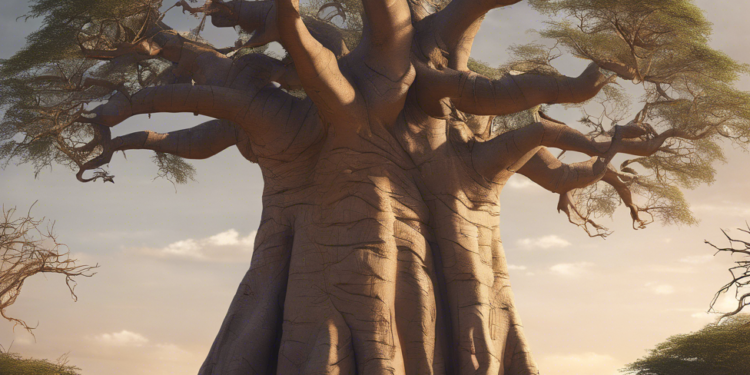The Tree of Life: A Living Testament of Time
In the heart of South Africa, nestled amidst the breathtaking landscapes of Limpopo province, stands a majestic living relic that has silently witnessed the passage of time for over two millennia. Known as the Tree of Life, this ancient marvel has become a symbol of resilience, endurance, and the intricate interplay between nature and history.
The Tree of Life, scientifically known as Adansonia digitata, is a species of baobab tree that is estimated to be around 2,000 years old. With its massive trunk and gnarled branches, it commands attention and evokes a sense of awe in all who lay eyes upon it. Standing at a height of over 70 feet and with a circumference of nearly 150 feet, this remarkable specimen is truly a living testament to the power and beauty of nature.
What makes the Tree of Life even more remarkable is its ability to adapt and survive in some of the harshest conditions on Earth. Baobab trees are known for their ability to store vast amounts of water within their trunks, enabling them to withstand droughts that would otherwise decimate other plant species. This adaptation has allowed the Tree of Life to endure through centuries of changing climates and environmental challenges.
Beyond its physical attributes, the Tree of Life holds a special place in the cultural and spiritual fabric of the region. Local communities consider it a sacred tree, rich in folklore and legends that have been passed down through generations. It is believed to possess healing properties, and its bark, leaves, and fruit have been used in traditional medicine for centuries.
The Tree of Life is also a gathering place for both locals and visitors alike. Its expansive canopy provides shelter and shade, creating a natural oasis in the arid landscape. People come to marvel at its grandeur, seeking solace and connection with the ancient wisdom it embodies.
However, despite its symbolic importance and the reverence it commands, the Tree of Life is not immune to the threats that face many ancient trees around the world. Climate change, deforestation, and human encroachment pose significant risks to its survival. Efforts are being made by conservationists and local communities to protect and preserve this living treasure, ensuring that future generations can continue to marvel at its splendor.
The Tree of Life stands as a silent witness to the passage of time, reminding us of the resilience and beauty of nature. It serves as a poignant reminder of our responsibility to protect and conserve the natural world around us. As we stand in awe of this ancient marvel, let us be inspired to treasure and safeguard the wonders that exist in our own backyards, for they hold the key to our shared past and the hope for a sustainable future. You May Also Like This
Some additional details about the Tree of Life:
1. Location: The Tree of Life can be found in the Mapungubwe National Park in Limpopo province, South Africa. The park is known for its diverse wildlife, archaeological sites, and stunning landscapes.
2. Age and Size: The estimated age of the Tree of Life is around 2,000 years, making it one of the oldest living baobab trees in the world. With a circumference of almost 150 feet, it is among the largest baobab trees as well. Its massive trunk and sprawling branches create a captivating sight.
3. Unique Features: Baobab trees are distinctive in appearance, with their thick, bottle-shaped trunks and sparse branches that resemble roots sticking out of the ground. The Tree of Life is no exception, showcasing the quintessential characteristics of the baobab species.
4. Cultural Significance: The Tree of Life holds deep cultural and spiritual significance for the local communities in the area. It is often regarded as a sacred tree, associated with legends, myths, and traditional beliefs. Many consider it a symbol of strength, wisdom, and longevity.
5. Ecological Importance: Baobab trees, including the Tree of Life, play a crucial role in their ecosystem. They provide shelter, food, and water for various animals, including birds, insects, and mammals. The tree’s hollow trunk can even serve as a refuge for animals during harsh weather conditions.
6. Threats and Conservation Efforts: Like many ancient trees, the Tree of Life faces several threats to its survival. Climate change, deforestation, and human activities such as land clearance and agricultural expansion pose significant challenges. However, local communities and conservation organizations are working together to protect and preserve this iconic tree, implementing measures to ensure its long-term survival. Read about living healthy lifestyle here.
7. Tourist Attraction: The Tree of Life has become a popular tourist attraction, drawing visitors from around the world. Its awe-inspiring presence and historical significance make it a must-visit destination for nature enthusiasts, photographers, and those seeking a deeper connection with the natural world.
The Tree of Life stands as a remarkable testament to the resilience of nature and the intricate relationship between humans and the environment. Its ancient roots and majestic presence inspire reverence, reminding us of the importance of preserving our natural heritage for future generations.
In the presence of the Tree of Life, we are reminded of the power of nature, the importance of preservation, and the profound connection we share with the world around us. Let us cherish this living testament of time and ensure that its legacy continues for generations to come.
Read about latest in Technology Here













Comments 1